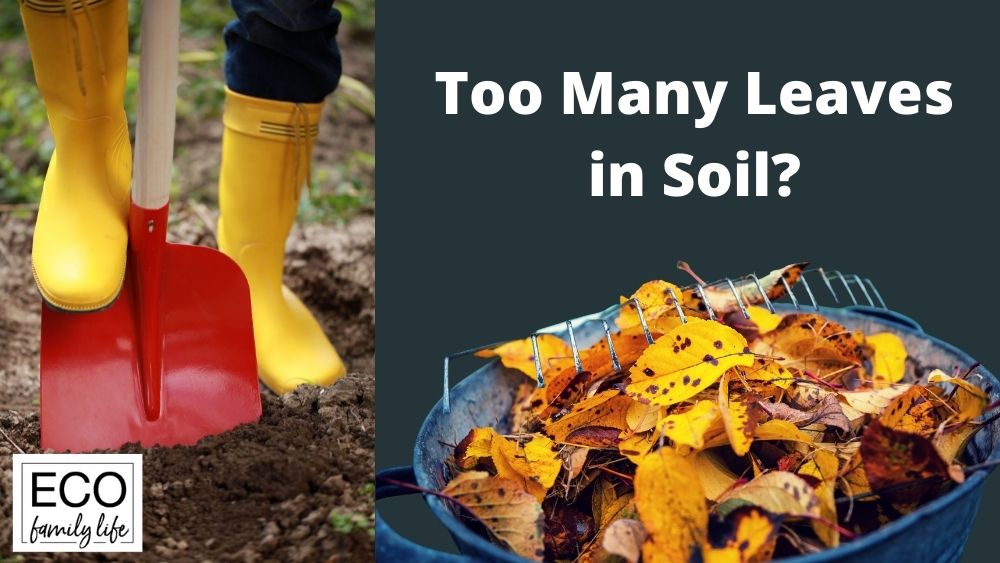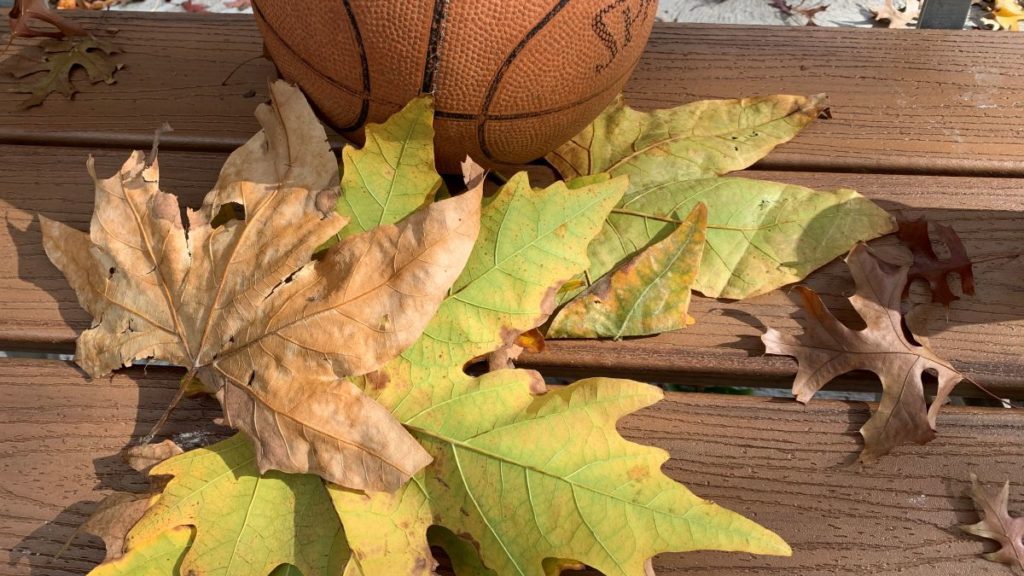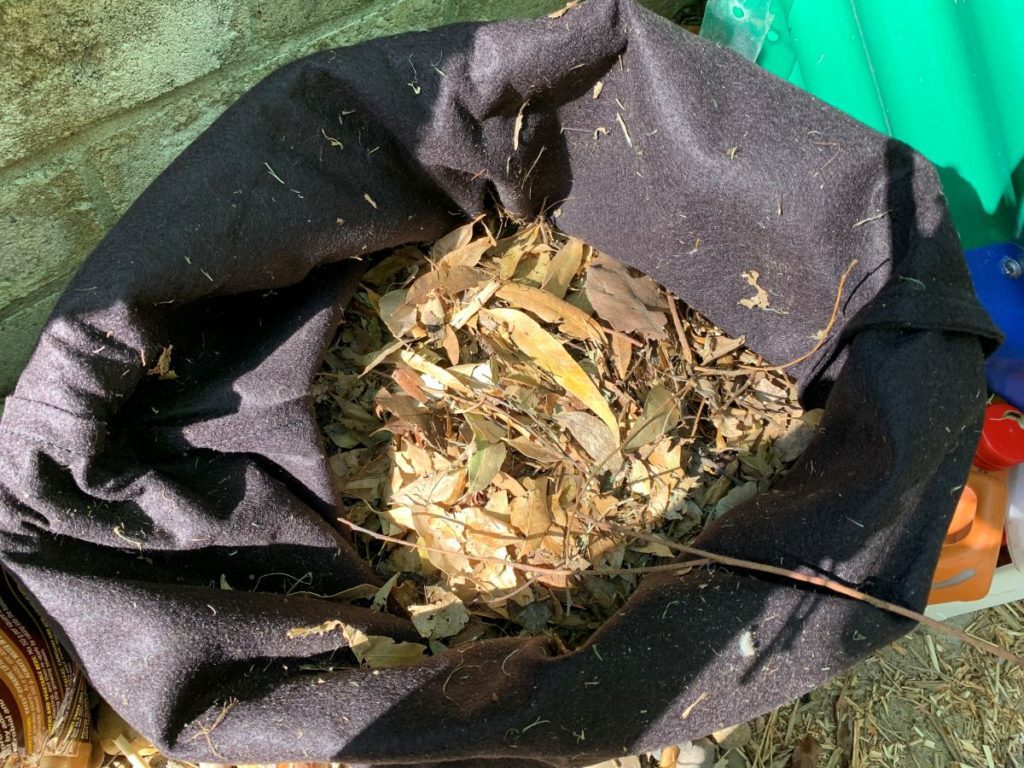Adding too many leaves and mixing them through garden soil can cause a temporary uptake of nitrogen from the soil. As soil bacteria break down the leaves in the soil they will draw nitrogen from the soil for a short time which can slow plant growth.
To help leaves to break down as fast as possible break them down in a compost pile or worm farm instead of mixing leaves through the soil.
Leaves that have been mixed through your garden soil will break down slowly but can cause the soil to dry out if you add lots of them. They will break down slower than when mixed into compost.

You can mix fall leaves with other mulch types like bark, sugar cane, straw or lucerne. This will make a great mulch for trees and shrubs and the bark will help to stop the leaves from blowing away.
This article will explore what happens when you dig leaves into your soil, what other options you have when dealing with leaves and how to break them down fast.
What happens when you dig too many leaves into your soil
Digging leaves into your garden soil will allow soil bacteria and worms to move in and break them down. Here are the top 5 results of digging too many leaves through your garden soil.
1. The soil can dry out
One of the first things that can happen when you mix too many fall leaves through your soil is that it will dry out. Adding lots of dry leaves will create gaps, can absorb water and can result in more water evaporating from the soil. It can make it difficult to plant into this mix because the plant will dry out fast.
2. A small amount of nitrogen will be taken up from the soil
When fall leaves, dry perennials leaves or green leaves are dug through the soil bacteria will move in to break them down. There will be a small absorption of nitrogen by the bacteria from the soil as they break the leaves down.
They will eventually release the nitrogen back into the soil as they break the leaves down. Adding a lot of leaves however can mean that more nitrogen is absorbed and can affect plant growth. You can add a bit of aged manure to replace the nitrogen as you mix them in.
3. Leaves will take longer to break down in soil than compost
Leaves that are dug into soil will take longer to break down than when they are mixed into a healthy compost pile. In the soil there will be less moisture and less concentrated soil bacteria populations. This means that they will break down in the soil but it won’t be fast.
For the fastest way to break down leaves it is better to break them down in a compost pile and then add the compost to your soil. You will get the benefit of the organic matter, nutrients and avoid the minor, temporary loss of nitrogen.

The best ways to use leaves in the garden
Rather than digging leaves through soil, here are some other great ways to use leaves in your garden. These are good options instead of mixing them through your ground soil.
1. Put them in a compost bin or bag
Making leaf compost in a bag or in a wire cage is a great way to deal with your leaves. You can add only fall leaves and coffee grounds and after around 9 months you will have leaf mold. You can add other brown materials like straw or hay and green materials like food scraps if you like.
Making compost from fall leaves is easy and will capture all of the nutrients left in the leaves for your garden. You can mix small amounts of fall leaves through your compost throughout your compost by saving them in a compost bag in fall.

I like to collect fall leaves in compost bags that are made from organic material. This means that I can set them outside and the water from rain will wash straight through them. If the leaves are left in the bag throughout the year they will break down in the bag on their own.
2. Use leaves for worm farm bedding

Leaves are great to use for worm farm bedding. Use dry leaves to top off your worm farm to help to cover the food scraps and stop ants and flies from visiting. You can also mix leaves through with shredded paper as a base for your worm farm.
Layer 2-3 inches of this material on the base of your farm or on the new layer of your worm tower. Worms love to eat fall leaves and will digest them over a few weeks.
3. Use leaves as a mulch for garden beds
Use fall leaves as a mulch for your garden beds including for your fruit and vegetables. You can use them to mulch strawberries and larger fruit trees like citrus trees and mangoes. You can scatter the leaves under established trees, leave them on your garden bed as they drop or put them on top of your raised garden beds.

Check out my article here for how to use fall leaves as mulch: Mulching with Leaves | An Easy Guide
4. Mulch leaves into your lawn clippings
Another great way to deal with fallen leaves is to run over them with your mower using the mulching function. This will break them up into small pieces. Small amounts of fall leaves can be left on your lawn to break down.
You can also rake up or collect the lawn clippings in the catcher and put them straight into your compost. Keep them in a compost bag ready to add to your worm farm when you need to or let them dry out and use them as garden mulch.
5. Mix them into your soil
You can mix leaves through your soil in small amounts, but it is best to mix through aged manure at the same time. This will give the soil a boost of nitrogen and help to reduce the temporary reduction in availability of nitrogen in your soil.
Too Many Leaves in Garden Soil | Summary
If there are too many leaves in your garden soil it can be hard to get your new plants going. Digging leaves through the soi where established plants are growing can damage the roots of the trees or shrubs nearby. It is much better to compost leaves or mix them together with other mulch materials and layer them on your garden beds.
Fall leaves are a great ingredient for your garden and I always collect bags of them to use throughout the year. I will use handfuls for my worm farm, to add extra mulch under fruit trees or leave them in the bag to break down.
Happy growing.
I am an accredited practicing dietitian, experienced gardener and a dedicated cook. I love writing and sharing my experience so you can learn from my successes and mistakes.
